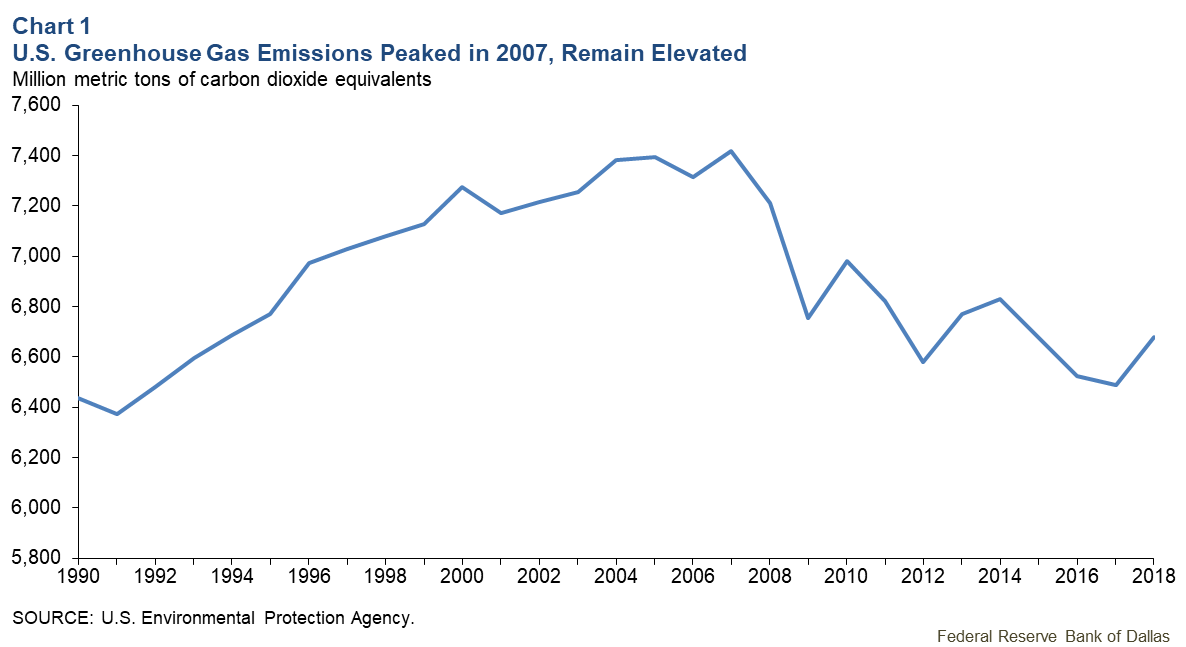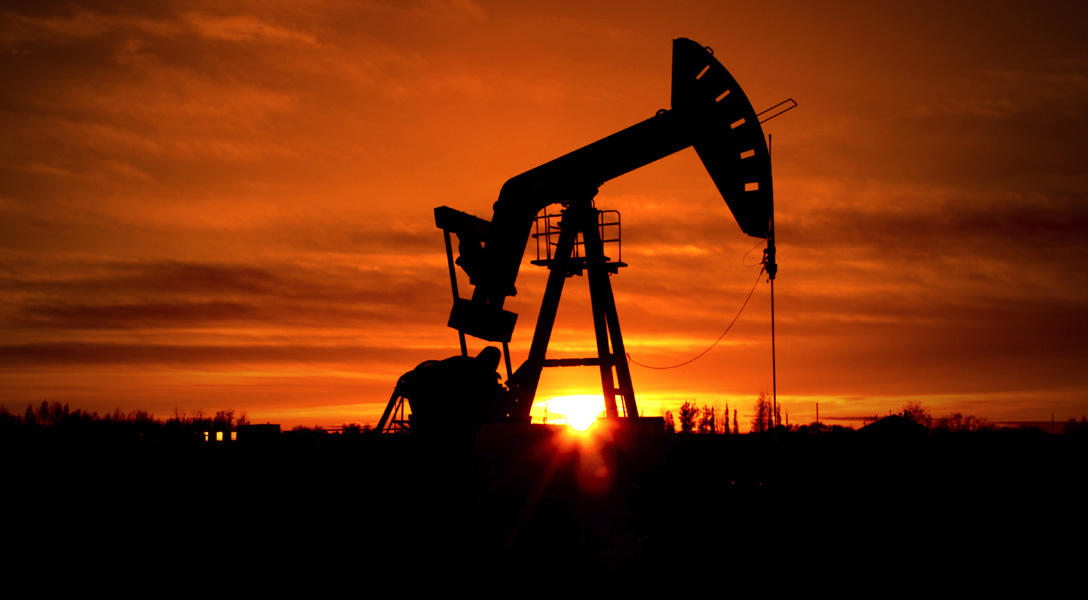
What Is the U.S. oil industry doing about greenhouse gas emissions?
The rapid increase in greenhouse gas emissions in recent decades has contributed to global warming. U.S. greenhouse emissions peaked in 2007 but remain elevated (Chart 1). About 81 percent of these emissions consist of carbon dioxide (CO2), and an additional 10 percent consist of methane.

According to the U.S. Environmental Protection Agency, the oil industry contributes only 6 percent to U.S. methane emissions, which is negligible relative to the contributions of agriculture, natural gas production and transportation, coal mining and waste management. In contrast, the oil industry is a major contributor to CO2 emissions.
CO2 is created when fossil fuels such as oil products or natural gas are consumed. The oil industry contributes to U.S. CO2 emissions directly, mainly through the flaring of excess natural gas by oil producers and refiners, which accounts for about 25 percent of oil-related CO2 emissions. It also contributes indirectly by selling oil products such as gasoline, diesel or jet fuel to households or other sectors of the economy. Consumption of these products accounts for about 75 percent of the nation’s oil-related CO2 emissions.
The transportation sector alone, which relies heavily on fossil fuels, is responsible for one-third of all energy-related U.S. CO2 emissions. Its contribution is second only to electric power generation.
The response of major oil companies
Oil companies have felt compelled to react both in anticipation of new regulatory policies and in response to growing pressure from investors. Recently, BP and Shell announced a net-zero emissions target by 2050. In October, ConocoPhillips became the first major U.S. oil producer to set a net-zero emissions target for its operations by 2050. Next, Occidental Petroleum in November announced a similar net-zero emissions target. However, only BP and Occidental promise to offset not only their operational emissions by 2050 but also the emissions generated by consumers of their oil products.
Plans to reduce emissions
Oil companies have two main means of reducing their CO2 emissions. One is a reduction in the flaring of excess natural gas from oil wells and in oil refineries. This requires capturing this natural gas, processing it and selling it. CO2 savings occur to the extent that less natural gas is required from other sources.
The other tool is carbon capture and sequestration, which refers to capturing CO2 emissions from factory sites or from the air and storing the CO2 below ground indefinitely, preventing it from entering the atmosphere. This conceivably would allow companies to remove as much CO2 as they create, reducing to zero their net contribution to emissions.
Reducing flaring at the wellhead
CO2 emissions from flaring natural gas during the start-up of a shale oil well have received much attention. If this gas, which consists mostly of methane, cannot be removed, it must be flared for safety reasons. This avoids releasing the methane but creates CO2 emissions.
A 2019 Dallas Fed survey suggests that the main reason companies resort to flaring is that the small volume of gas generated by small oil producers makes it uneconomical for pipeline companies to build lines to remove the gas (Chart 2).

This highlights the advantages of being a large oil company. Whereas the average flaring rate in the Permian region is 3.7 percent, the larger oil producers’ flaring rates are as low as 0.8 percent. A recent wave of mergers and acquisitions in the shale oil sector will likely make it easier for oil companies to negotiate with gas pipeline companies.
There is evidence that companies are increasingly prioritizing environmental concerns. For example, in 2020, nine of the 11 top producers in the Permian region planned to issue an annual sustainability report, and seven have an explicit or implicit flaring target.
Indeed, the emission intensity from flaring in the Permian declined in 2019 for the first time in many years, as additional natural gas pipeline capacity was created. Projections for 2020 from Rystad Energy, a data analytics firm, show a rapid further decline in flaring, reflecting in part declining oil production due to the COVID-19 pandemic but also the introduction of flaring targets.
Potential for carbon capture and sequestration
Of even greater potential are new technologies for capturing CO2 and storing it underground. Oil companies’ unique capabilities and knowledge of geology allow them to become leaders in this effort.
Sequestering carbon below ground allows oil companies to offset their emissions by earning carbon credits to be used against the CO2 they emit. Potential storage capacity in the United States amounts to 160 years of domestic emissions from all sources.
Currently, a U.S. tax credit incentivizes these efforts. Plans are underway for nearly a dozen commercial-scale carbon repositories along the Gulf Coast. The main challenge is scaling up experimental technology to remove CO2 from the air. Widespread adoption of this technology would be facilitated by adequately pricing CO2. This decision will be up to the incoming U.S. administration.
The price of electricity from wind and solar has come down a lot in recent years. However, natural gas power plants remain essential to stabilizing the power grid, short of major advances in battery technology that allow the storage of electricity generated by wind and solar energy. Natural gas also remains essential for home heating.
Similarly, the threat to oil demand from electric vehicles is not imminent, since a rapid expansion of the production of battery-powered cars does not seem feasible in the near term. As a result, one would expect a long energy transition during which oil and natural gas will remain important, as will carbon emissions, which provides the basis for sequestration to play an important role in reducing greenhouse emissions for many years.
What Is eriving the energy transition?
Clearly, the demand for oil depends on how fast the transition to low-emission technologies occurs. This is particularly true for the transition to electric cars. It is important to understand that public policy is driving this transition more than consumers.
Given the fiscal strains imposed by COVID-19, governments worldwide will find the cost of subsidizing the infrastructure for electric vehicles (such as abundant fast-charging stations across the country, power generation and distribution) extremely challenging, reducing the demand for electric vehicles.
Moreover, even with purchase subsidies on electric vehicles, most consumers do not want to buy electric vehicles for a variety of reasons. To induce consumers to buy electric vehicles, governments may increase gasoline taxes, impose taxes on automobiles with internal combustion engines or mandate local driving prohibitions, but such measures are not popular with voters.
The European Union and many individual European countries (including the U.K.), therefore, are working on outlawing sales of cars using internal combustion engines in 2030 (with hybrids to follow in 2035). This effectively forces automakers to only produce electric cars and takes the choice out of consumers’ hands. So far, the U.S. has not adopted similar policies, but California recently banned internal combustion engines starting in 2035, and there is a similar proposal at the national level before Congress. How such a policy shift would address the lack of infrastructure, especially in rural areas, remains an open question.
There were close to 290 million motor vehicles in the U.S. in 2019. With about 6 million new vehicles registered each year, it will take a long time to replace them. Even replacing all cars and light trucks with electric vehicles, however, would only cut about 20 percent of domestic CO2 emissions. Thus, efforts to curb emissions linked to the U.S. oil industry are only a small part of a bigger problem that will require substantial popular and political will to address.
About the Author
Lutz Kilian
Kilian is a senior economic policy advisor in the Research Department at the Federal Reserve Bank of Dallas.
The views expressed are those of the authors and should not be attributed to the Federal Reserve Bank of Dallas or the Federal Reserve System.



